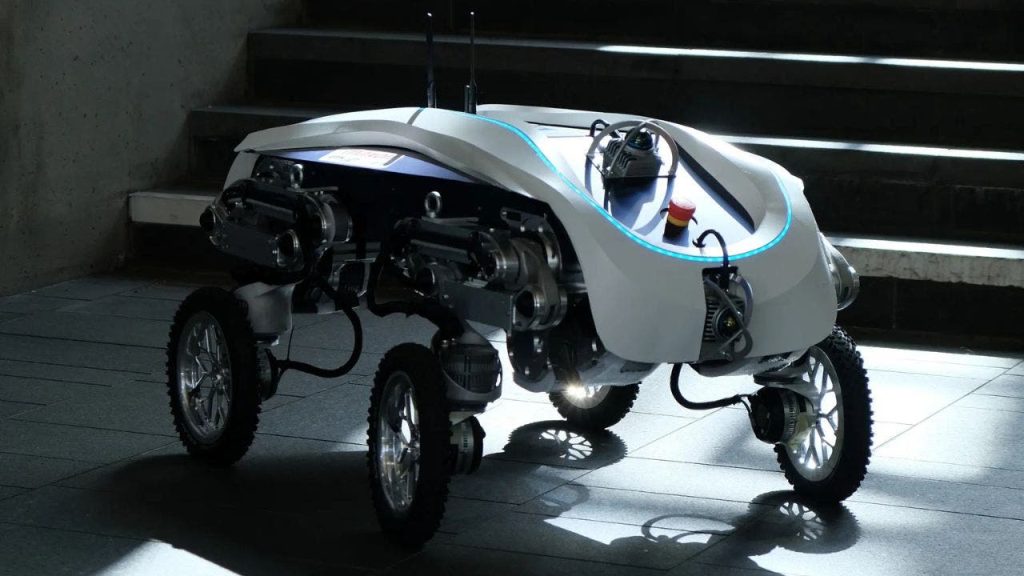In a pioneering advancement within the field of robotics, LEVA—a newly developed autonomous delivery robot—can both navigate complex environments and autonomously load and unload heavy cargo. Developed by engineers and designers from ETH Zurich and other Swiss institutions, LEVA aims to transform goods delivery, making it smoother and more efficient. The robot’s unique combination of wheels and legs allows it to adapt to various terrains, potentially revolutionizing logistics in urban and rural settings alike.
| Article Subheadings |
|---|
| 1) What distinguishes LEVA from other delivery robots? |
| 2) How does LEVA perceive its surroundings and navigate? |
| 3) The significance of LEVA’s autonomous loading and unloading capabilities |
| 4) Where might we see LEVA in action? |
| 5) Future prospects for LEVA and robotic deliveries |
What distinguishes LEVA from other delivery robots?
Unlike most delivery robots that rely on wheels or legs separately, LEVA ingeniously integrates both mechanisms. With four legs ending in motorized, steerable wheels, it can roll across smooth surfaces such as sidewalks quickly, resembling a miniature vehicle. However, when faced with obstacles like stairs or uneven terrain, LEVA can lock its wheels and utilize its legs to climb or walk, much like a quadruped. This feature enables the robot to efficiently traverse both urban environments and rugged outdoor settings, making it a versatile solution for a variety of delivery scenarios.
How does LEVA perceive its surroundings and navigate?
LEVA employs an advanced mix of GPS technology, lidar sensors, and a network of five strategically positioned cameras to gather data about its surroundings. This sensory toolkit allows the robot to expertly navigate through busy city streets or indoor areas while skillfully avoiding obstacles. One of its cameras is dedicated to focusing downward, enabling it to align precisely for effective cargo pick-up and drop-off. This multi-faceted approach to perception ensures that LEVA can operate efficiently and safely in diverse environments.
The significance of LEVA’s autonomous loading and unloading capabilities
One of the standout features of LEVA is its ability to autonomously load and unload cargo without human intervention. The process begins when LEVA locates a standard cargo box. It then approaches, lowers itself by bending its legs, and secures the box using powered hooks that attach beneath its body. Once the box is secured, LEVA raises itself and transports the cargo to its intended destination. This feature is particularly impressive considering LEVA can handle loads weighing up to 187 pounds—an extraordinary feat for a robot of its size. As a result, LEVA holds significant potential for reducing the labor costs involved in delivery logistics while enhancing safety by minimizing manual labor-related injuries.
Where might we see LEVA in action?
The versatility of LEVA suggests it could be employed in various sectors. One potential application is in urban settings, where it could deliver packages directly to residents of buildings with stairs, thereby circumventing common logistical challenges. In agricultural contexts, farmers might utilize LEVA for transporting supplies across uneven fields. During construction projects, it could carry essential tools and materials through challenging terrains. Additionally, in emergency situations, LEVA could help deliver vital supplies across debris or rough ground, thereby enhancing response times in critical scenarios. Overall, its adaptability makes LEVA a viable asset in a broad spectrum of industries.
Future prospects for LEVA and robotic deliveries
While the initial prototype of LEVA has demonstrated significant capabilities, ongoing research and development aim to refine its energy efficiency, enhance its stair-climbing abilities, and improve its operational autonomy. The overarching objective is to integrate LEVA into automated delivery systems for seamless performance in real-world conditions. As advancements continue, LEVA is well-positioned to reshape traditional delivery methods, offering faster, safer, and more efficient means of transporting goods.
| No. | Key Points |
|---|---|
| 1 | LEVA combines wheels and legs for versatile mobility. |
| 2 | Utilizes GPS, lidar, and cameras for navigation and obstacle avoidance. |
| 3 | Able to autonomously load and unload cargo, handling weights of up to 187 pounds. |
| 4 | Potential applications include urban deliveries, agriculture, and construction. |
| 5 | Ongoing developments aim to improve efficiency and autonomy for practical deployment. |
Summary
LEVA represents a significant leap forward in the field of autonomous delivery robots. By combining innovative mobility solutions with advanced sensory technology, it has the potential to streamline various delivery processes across numerous sectors. As ongoing developments aim to enhance its capabilities, LEVA could ultimately change the landscape of logistics and material handling, making it a noteworthy advancement for industries reliant on efficient delivery solutions.
Frequently Asked Questions
Question: What is the maximum weight LEVA can carry?
LEVA can handle cargo loads weighing up to 187 pounds, allowing it to transport a variety of items efficiently.
Question: How does LEVA navigate complex terrains?
LEVA utilizes a combination of GPS, lidar sensors, and multiple cameras to understand its surroundings and navigate obstacles in both urban and rural environments.
Question: What industries could benefit from LEVA’s capabilities?
LEVA could be particularly useful in urban logistics, agriculture, construction, and emergency response, offering versatility in various operational scenarios.
